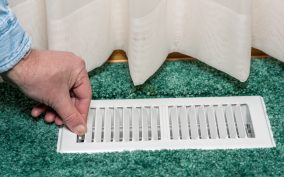Apr 21 2025
What Are the Signs of Poor Indoor Air Quality?
Did you know that Americans spend about 90% of their time indoors? From cozy evenings at home to long hours in office spaces, we’re constantly breathing in indoor air. But here’s the catch—the number of pollutants in these spaces is likely two to five times higher than in the outdoors.
At Van Drunen Heating & Air Conditioning, we’ve seen it all—what looks like a safe and comfy environment could be silently contributing to allergies, respiratory issues, and unexpected home repair costs. The good news? Recognizing the signs of poor indoor air quality can help homeowners take immediate steps to create cleaner, healthier living spaces. Here are some of the signs you should be on the lookout for.
Common Signs of Poor Indoor Air Quality
Many telltale signs can indicate that your home’s air quality might not be as pristine as you think. Here’s what to look out for:
1. Allergies, Irritations, or Respiratory Problems
If you or your family members are frequently coughing, sneezing, or experiencing watery eyes or difficulty breathing, your indoor air may be to blame. Contaminants such as mold spores, pet dander, pollen, or even chemical fumes from furniture can aggravate allergies or trigger asthma symptoms.
2. Headaches and Dizziness
Frequent headaches or symptoms like dizziness and nausea can stem from airborne irritants, such as volatile organic compounds (VOCs) emitted by cleaning products, paints, or adhesives. Poor ventilation only worsens the problem by trapping contaminants indoors.
3. Insomnia and Fatigue
Struggling with restless nights? Dust, pollen, and other irritants in the air can affect your sleep quality. If you wake up tired or feeling sluggish during the day, it might be time to evaluate your IAQ.
4. Excessive Dust Accumulation
If it feels like you’re dusting surfaces every other day, you may have poor air circulation or a clogged HVAC filter that’s dispersing particles instead of filtering them out.
5. High Energy Bills
A sudden spike in your bills might be linked to poor air quality. Dirty HVAC filters or dusty air ducts force your systems to work harder, draining energy and your wallet.
6. Unpleasant Odors
Persistent smells, whether musty, chemical-like, or smoky, can indicate issues such as mold growth, high humidity, or VOCs lingering in the air.
7. High Humidity Levels
When the air feels damp or sticky indoors, high humidity levels are likely at play. Excess moisture can cause mold, mildew, and dust mites—all of which negatively impact air quality.
8. Condensation on Glass Surfaces
Condensation buildup on windows and glass doors is another clue that your home could have a humidity imbalance. Over time, this can contribute to warped wood, peeling paint, and mold growth.
9. Mold or Mildew Growth
Noticed patches of dark spots in damp areas? Mold and mildew thrive in spaces with poor ventilation and excess moisture. They release spores into the air, exposing your lungs to harmful toxins.
10. Unusually Stale Air
If your home feels stuffy or smells stagnant despite regular cleaning, your ventilation system might not be properly circulating fresh air.
Why You Shouldn’t Ignore These Signs
Health Implications
Poor indoor air quality doesn’t just cause discomfort—it can severely impact your long-term health. Continuous exposure to pollutants like mold spores, VOCs, and allergens can lead to respiratory conditions, skin irritation, and worsened asthma symptoms. For children and the elderly, the risks are even higher.
Financial Implications
Ignoring IAQ issues can also hit you hard financially. Mold remediation, HVAC repairs, and skyrocketing energy bills add up. By addressing air quality concerns early, you avoid hefty expenses down the line and maintain a more energy-efficient home.
How to Improve Indoor Air Quality
Now that you know the signs of poor IAQ, here are practical steps you can take to address the problem:
Ventilation Matters
- Open up windows and doors whenever possible to bring in fresh air.
- Use fans in kitchens and bathrooms to remove smoke, steam, and pollutants.
Invest in Air Purifiers
- Consider purchasing air purifiers that are equipped to capture allergens, smoke particles, and VOCs.
- Look into advanced systems like the Pure Air whole-home air purification system, recommended by Van Drunen Heating & Air Conditioning.
Regular HVAC System Maintenance
- Replace filters every 1-3 months to avoid dust and allergens clogging your HVAC system.
- Schedule professional HVAC inspections at least twice a year for optimum performance.
Control Humidity
- Use dehumidifiers to maintain indoor humidity levels.
- Address water leaks or moisture issues immediately to prevent mold.
Professional Services for Lasting Solutions
Sometimes, DIY solutions aren’t enough when it comes to maintaining good indoor air quality. That’s where professional HVAC services step in. Many HVAC companies offer comprehensive IAQ assessments and solutions designed to help your family breathe easier. From air duct cleaning and sealing to humidity control and air purification systems, these professionals provide the expertise and tools needed to improve the air quality in your home.
Breathe Easier with Cleaner Air
Your home should be a sanctuary, not a source of frustration or health issues. Noticing the signs of poor air quality is the first step toward creating a healthier and more energy-efficient environment.
At Van Drunen Heating & Air Conditioning, we understand how important air quality is to your family’s well-being. If you suspect your home’s air isn’t up to par, don’t wait—connect with our team today to discuss tailored solutions.




